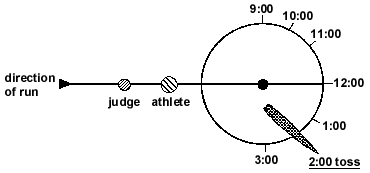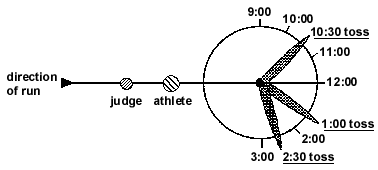Tossing the Caber
There is no standard size or weight of a caber but the caber should be of a length and weight such that at least half the competitors can turn it. The caber is to be made only of wood. The caber shall be placed upright for the competitor, with the heavy end on top. The attempt begins when the competitor lifts the caber from the ground. If the competitor drops the small end of the caber back to the ground after having picked it up, this shall count as one attempt. It is recommended that a back judge and a side judge be used. The judge may set boundaries if he feels the ground in a certain area is not suitable for the caber to be tossed or to provide safety for the spectators. The competitor may take any length of run they wish and may toss the caber from where they choose, as long as it is within the judge's boundaries. The caber must pass through the vertical position (90 degrees from the ground) in order to count as a turned caber. It is up to the side judge to determine if the caber has passed through it. The "clock face method" of judging shall be used. The caber in a perfect toss will pass through the vertical position and land with the small end pointing directly at 12 o'clock away from the competitor in an imaginary straight line extending from the competitor through the initial landing point and in line with the direction of the run. An overhead view is drawn in Figure 2 below to demonstrate a 12 o'clock toss.
A valid throw is when the small end of the caber passes through the vertical position and falls away from the competitor to land within the 180 degree radius between 9 o'clock and 3 o'clock. An overhead view is drawn below in Figure 3 to demonstrate some turned cabers and how to score them.
If the caber lands in a 12 o'clock position pointing away from the competitor but not in a direct line with their run (as when a competitor turns to one side at the last step or two), then the judge must determine the competitor's direction of run and then look through the competitor to the small end of the caber, thus giving a true reading of its relation to the direction of run. The direction of run is determined by the direction in which the competitor runs after having control of the caber. An overhead view is drawn below in Figure 4 to demonstrate a toss such as this.
Once the competitor has started on his run, the judge should pick a point in the horizon to use as a reference point once the toss has been made. The competitor may run in one direction and then stop and change directions as long as they show control over the caber. The caber shall be judged on its landing position, not the position to which it may bounce or roll.
If the caber is not turned by the competitor, then it is the responsibility of the side judge to determine the angle at which the caber was tossed with respect to the 90 degree vertical. The side judge should be perpendicular to the competitor's direction of run in order to make an accurate call. A drawing of a view from the side judge's position is shown below.
Each competitor is allowed three attempts, all of which should be scored and the best of these to be used to determine placing. In the event of a tie then the next best attempt or attempts shall be used to determine placing. The order of placing shall be determined by the nearest to 12 o'clock toss made by a competitor. If the competitor did not turn the caber, then placing shall be determined by the toss closest to the 90 degree vertical.
If after one complete round the caber has not been turned by any competitor and the judge agrees, the caber may be cut. The caber shall be cut from the large end and the amount is to be determined by the judge. This process can be repeated until the caber has been turned. When a qualifying caber is used then any successful turn qualifies the competitor for the next caber.
Ties are broken by comparing the next best attempt for each competitor involved in the tie. The competitor with the next best score places highest. If other ties occur, this process is repeated for all previous attempts.



